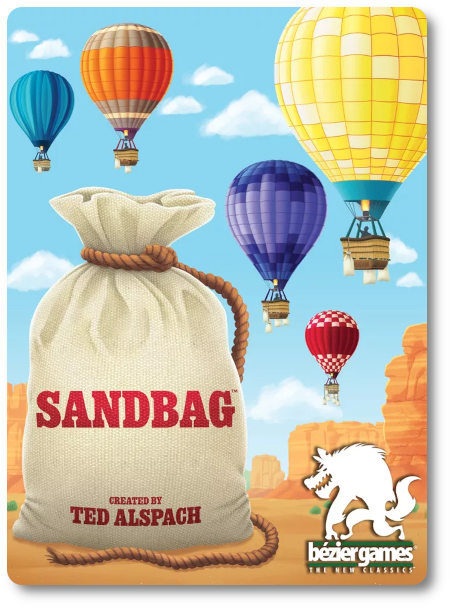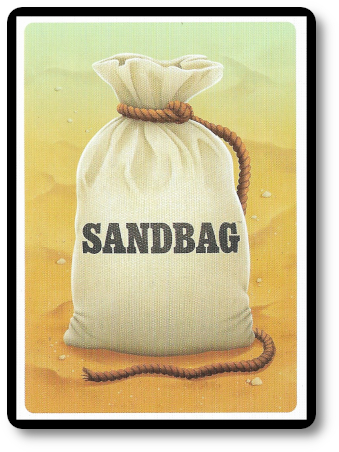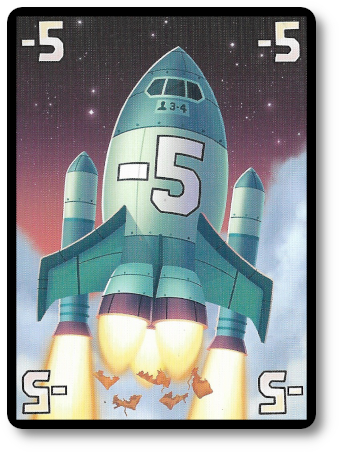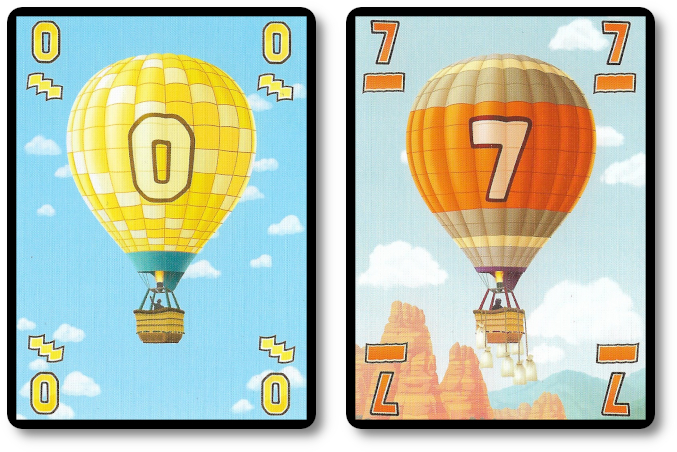 The Basics:
The Basics:
- For ages 10 and up
- For 3 to 6 players
- Approximately 30 minutes to complete
Geek Skills:
- Counting & Math
- Logical & Critical Decision Making
- Pattern/Color Matching
- Strategy & Tactics
- Risk vs. Reward
- Hand/Resource Management
Learning Curve:
- Adult – Easy
- Child – Moderate
Theme & Narrative:
- A tactical and strategic trick-taking card game that will get a rise out of you
Endorsements:
- Gamer Geek approved!
- Parent Geek approved!
- Child Geek approved!
Overview
In an age where we can travel into space and fly around the world in jets, there is still something romantic and awe-inspiring about hot air balloons. These majestic and often colorful contraptions are nothing more than a giant balloon filled with hot air and a basket for those brave enough to ride in. I have no interest in ever riding in one, but I am always compelled to stop and watch as one goes slowly across the sky. Such is the power and beauty of watching something the size of a large house float by silently in a world where everything around us makes noise. In this game, you’ll be one of the brave souls who can ride aloft in the sky in a basket as your balloon lifts you into the clear blue.
Sandbag, designed by Ted Alspach and published by Bézier Games, is comprised of 71 cards. The cards are as thick and durable as your standing playing card. Illustrations by artist Greg Bartlett are bright and colorful, supporting the game’s theme very well. Not included with the game, but necessary to play, is a pen or pencil and something to write on to keep track of the players’ scores.
Fun fact about the cards:
- The Rocket cards negate Sandbags. The illustration for the Rocket cards shows the rocket destroying the same number of Sandbags it cancels.
- The lower the number value, the higher the balloon is in the sky, as illustrated on the Balloon cards.
Prepping Your Balloon
To set up the game, complete the following steps:
First, remove several Rocket and Balloon cards per the number of players as indicated by the game’s rule book. These cards should be placed back in the game box for now.
Second, shuffle the Balloon and Rocket cards that remain in play together.
Third, deal out all the cards, face-down, evenly to all the players.
Fourth, after all the players view the cards in their hands, each player should choose one card to give to the opponent to the left and one card to give to the opponent to their right, face-down. Any card in the player’s hand may be passed. After the players have been given two cards, they should pick up the cards given to them and add them to their hands.
Fifth, each player places two cards of their choice face-down in front of them and next to each other. This is referred to as the player’s “Basket.” Then, the player places a third face-down card adjacent and sideways to the Basket. This is referred to as the player’s “Sandbag.” Once every player has selected and placed their Basket and Sandbag cards, they simultaneously flip over to reveal the cards in their Basket, keeping them in their current position. The Sandbag card remains face-down.
This completes the game setup. Give each player a Reference card if needed and begin. The player with the highest trump color in their Basket goes first.
Tricks, Trumps, Rockets, Sandbags, and Balloons
Sandbag is a trick-taking card game. For those familiar with card games such as Hearts and Spades, you’ll feel almost immediately at home. Almost. Sandbag has some exciting twists and turns that give the player ample opportunity to manipulate the game and their opponents.
To begin with, trump is based on whatever color is the most prominent in all of the player’s Baskets. This means all the players contribute to what might be the trump color for the round, but it also means the trump color will shift during a round.
Players can manipulate the trump color and their opponent’s cards by swapping. This is done by playing any card in front of an opponent, replacing the card they take from their hand, and turning it face-down (making it a Sandbag – we’ll talk about these cards in a moment). The card they take must be immediately played to the center. The only time a player can’t swap a card is if they have a card of the same color as the lead card in their hand unless they are swapping a card for a Rocket card or a Balloon card of the same color (in which case, go for it).
This brings me to Sandbags and Rocket cards. Sandbags are null cards. That is to say, they have no color and no number value. They are not invalid so much as worthless, which is great. They allow the player to contribute to the card plays but without any real chance of winning the trick. That’s a very good thing, as players in Sandbag do not want to earn points.

Rocket cards reduce the number of points taken in a trick (again, a good thing).

All other cards are Balloon cards, providing color and number values (0 through 10).

Admittedly, that sounds like a lot to keep track of. Not to worry; the game designers thought of that and provided handy Reference cards to remind the players what trump is and how to properly swap cards. We did find that the first round of gameplay with new players was a bit awkward as they learned the ways and means to manipulate and play cards. By the second round, they knew more than enough to play well, and by the third round, they seldom used the Reference card.
Quick Word on Wording
As the game progresses, the players will be given opportunities to play cards from and to different areas of the game. To help keep everything clear, here is a quick cheat sheet.
- Player Hand: All cards the player is holding
- In Front: These cards sit directly in front of the player and include the player’s Basket and initial Sandbag
- Center: The cards being played during the trick (one per player)
Got it? Good. You’ll need to keep these three areas in mind as we continue to review the game.
Taking Flight
Sandbag is played in tricks and rounds for three rounds per game. A single trick is summarized here.
Step One: Play the Lead Card
The starting player for the trick (as determined when the game is set up and passed to the player who won the previous trick) plays a card from their hand. As mentioned, there are several different ways the player can play cards, including the first card. Players should also keep in mind what the current trump color is to ensure they win or don’t win the trick per their current strategic and tactical approach.
The starting player may do any of the following on their turn:
- Play one card from their hand to the center of the table (this could be a Balloon card or a Rocket card)
- Play a face-down Sandbag card in front of them to the center of the table
- Play a face-up Basket card in front of an opponent to the center of the table (swapping cards)
The card played is considered the “lead card.”
Step Two: Play Cards in Response
In turn order sequence, starting with the player directly to the left of the starting player, each player now plays one card in response.
By default, players must play a card from their hand that matches the color of the lead card. There are, of course, exceptions that make Sandbag such an exciting game. Players can do the following on their turn when playing a card in response to the center.
- Play a card of the same color as the lead card if they have at least one card of that color in their hand to the center, or…
- Play a face-down Sandbag in front of them to the center (even if the player has cards in their hand that match the lead card’s color), or…
- Play a Rocket card from their hand or their Basket to the center (again, even if the player has cards that match the lead card’s color), or…
- Take any face-up card in front of an opponent and play it to the center, replacing the card they take with any card from their hand that they play face-down in front of the opponent (giving their opponent a Sandbag for future tricks and significantly possibly changing the trump color), but only if any of the following is true:
- The player is playing the first card in the trick
- The player takes a card of the lead color
- The player has no cards in their hand in the lead color
- The player has only one card that matches the lead color, but they use that card to swap
Step Three: Determine Who Won the Trick
After all the players have played a card to the center, it’s time to determine who won the trick. This is done by doing a quick bit of calculation:
- The highest card value in the current trump color wins the trick
- If no trump colors were played, the highest card value of the led color wins the trick
The player who wins the trick takes all the cards in the center. All the collected cards remain or are placed face-down except the Rocket cards, which remain face-up.
This ends the trick. A new trick now takes place, with the starting player being the player who just won the trick. Continue until all cards are played out from the player’s hands.
Ending of the Round and Starting a New Round
It’s time to score the round after the last cards are played from the players’ hands and the last trick is collected. Points are counted as follows:
- +1 point for each face-down card, including any face-down cards in the player’s Basket
- -5 points or -7 points per Rocket card (depending on the number of players
- Plus, the sum of the face-up cards in the player’s basket
Once totaled, the number is added to any previous points scored in prior rounds.
The next round begins by collecting all the cards, shuffling them, and dealing them out as described in the game setup. In addition, for every 10 points scored, the player may place another face-down Sandbag card before the first trick.
Last Round and Ending the Game
The game ends after the last card is played, and the trick is collected during the third and final round. Players determine their score as previously described, adding or subtracting them to their total score. The player with the fewest points wins the game.
To learn more about Sandbag, visit the game’s web page.
Final Word
 Sandbag is a trick-taking game with a lot of strategy. That said, teaching the game to the Child Geeks was difficult, primarily due to the different ways the cards can be used. It took a few games before they understood the more subtle machinations of the game, but once they did, they were hooked. According to one Child Geek, “I like that you have different things you can do with your cards. You are never stuck with just what you have in your hand. You can play people’s cards, too.” Another Child Geek said, “I liked the balloons, and I liked the colors, and I liked that this game was all about not getting cards.” When the last balloon was set free and soared high into the sky, the Child Geeks all agreed that this game was high on their list.
Sandbag is a trick-taking game with a lot of strategy. That said, teaching the game to the Child Geeks was difficult, primarily due to the different ways the cards can be used. It took a few games before they understood the more subtle machinations of the game, but once they did, they were hooked. According to one Child Geek, “I like that you have different things you can do with your cards. You are never stuck with just what you have in your hand. You can play people’s cards, too.” Another Child Geek said, “I liked the balloons, and I liked the colors, and I liked that this game was all about not getting cards.” When the last balloon was set free and soared high into the sky, the Child Geeks all agreed that this game was high on their list.
 The Parent Geeks found Sandbag to be a real gem. One Parent Geek said, “It is so nice to play a trick-taking card game with a new twist. I greatly like my standby card games, but this is now my new favorite. I enjoyed how the cards were played, how the tricks were won, and the way the game always shifted around you. Chaotic? Sure, but so much fun.” Another Parent Geek said, “This game takes the traditional trick-taking approach and turns it on its head. It worked well, and I found myself enjoying every game. I’d play this again in a heartbeat.” When all the games were over, the Parent Geeks took a vote and determined that Sandbag was well worth their time.
The Parent Geeks found Sandbag to be a real gem. One Parent Geek said, “It is so nice to play a trick-taking card game with a new twist. I greatly like my standby card games, but this is now my new favorite. I enjoyed how the cards were played, how the tricks were won, and the way the game always shifted around you. Chaotic? Sure, but so much fun.” Another Parent Geek said, “This game takes the traditional trick-taking approach and turns it on its head. It worked well, and I found myself enjoying every game. I’d play this again in a heartbeat.” When all the games were over, the Parent Geeks took a vote and determined that Sandbag was well worth their time.
 The Gamer Geeks approached the game indifferently, finding most trick-taking card games on the market today stale and predictable. One Gamer Geek told me before we started playing, “if you’ve seen one trick-taking card game, you’ve seen them all.” After playing a single round, they changed their mind and said, “I was wrong. Very wrong. This game does have the trick-taking that I expected and I am not in the least bit excited about. What does make me happy is how we can play with the cards, how we can play off of our opponents, and all the different ways I can play to avoid taking cards. This is a clever little game, and I am most pleased to be surprised.” Another Gamer Geek said, after playing several games, “This is one of those card games I’d always want to play at the cabin, at the hotel, at the family gaming table, or whenever and wherever it was offered. It’s fast, fun, and, best of all, makes you think. I haven’t been this interested in a card game in some time.” When all the sandbags were cut, the Gamer Geeks found Sandbag to be a game just heavy enough to make for a significant lift in fun at the gaming table.
The Gamer Geeks approached the game indifferently, finding most trick-taking card games on the market today stale and predictable. One Gamer Geek told me before we started playing, “if you’ve seen one trick-taking card game, you’ve seen them all.” After playing a single round, they changed their mind and said, “I was wrong. Very wrong. This game does have the trick-taking that I expected and I am not in the least bit excited about. What does make me happy is how we can play with the cards, how we can play off of our opponents, and all the different ways I can play to avoid taking cards. This is a clever little game, and I am most pleased to be surprised.” Another Gamer Geek said, after playing several games, “This is one of those card games I’d always want to play at the cabin, at the hotel, at the family gaming table, or whenever and wherever it was offered. It’s fast, fun, and, best of all, makes you think. I haven’t been this interested in a card game in some time.” When all the sandbags were cut, the Gamer Geeks found Sandbag to be a game just heavy enough to make for a significant lift in fun at the gaming table.
 Admittedly, this game will cause you to raise your eyebrows for a few minutes regarding how it is played. You can use the cards and shift the cards in play at the table in your favor. That said, there are just as many ways to ensure you mess yourself up and accidentally get points. And that, I believe, is why the game was not only a bit difficult to teach but also so enjoyed once everyone knew how to play it. This game doesn’t show you all it can do until you are seated and dealt a hand. Then and only then do you go, “Oh, now I see.”
Admittedly, this game will cause you to raise your eyebrows for a few minutes regarding how it is played. You can use the cards and shift the cards in play at the table in your favor. That said, there are just as many ways to ensure you mess yourself up and accidentally get points. And that, I believe, is why the game was not only a bit difficult to teach but also so enjoyed once everyone knew how to play it. This game doesn’t show you all it can do until you are seated and dealt a hand. Then and only then do you go, “Oh, now I see.”
Which, again, made the game a bit tricky to teach. You can tell the players what their options are, but until they observe the context in which each of the choices is made – and its result – it won’t make any sense. This had me worried, as card games that are difficult to follow generally, as a rule, don’t do well at our gaming table. They come across as unnecessarily complex and are, therefore, undesirable. Sandbag was enjoyed by all. It’s a well-designed card game with elegant tactical gameplay that engages the players from start to finish and makes each game a unique opportunity to try new approaches and refine one’s strategy.
Yes, this is an excellent card game and one I am most pleased to have in my collection now. My only dislike is the game’s mandatory minimum number of players. Three players is awkward at the best of times, but finding a couple is pretty straightforward. Not to mention, the game quickly plays and is much more fun with six players. It’s a shame it isn’t available for just two, but then again, I don’t see how the game would work or be nearly as entertaining. You need people to shift the cards like a fickle wind to keep things blowing in the right direction.
Do try Sandbag when you get a chance. It’s a solid game full of tactical options and fun strategic approaches that will never fall flat.
This game was given to Father Geek as a review copy. Father Geek was not paid, bribed, wined, dined, or threatened in vain hopes of influencing this review. Such is the statuesque and legendary integrity of Father Geek.
Discover more from Father Geek
Subscribe to get the latest posts sent to your email.





